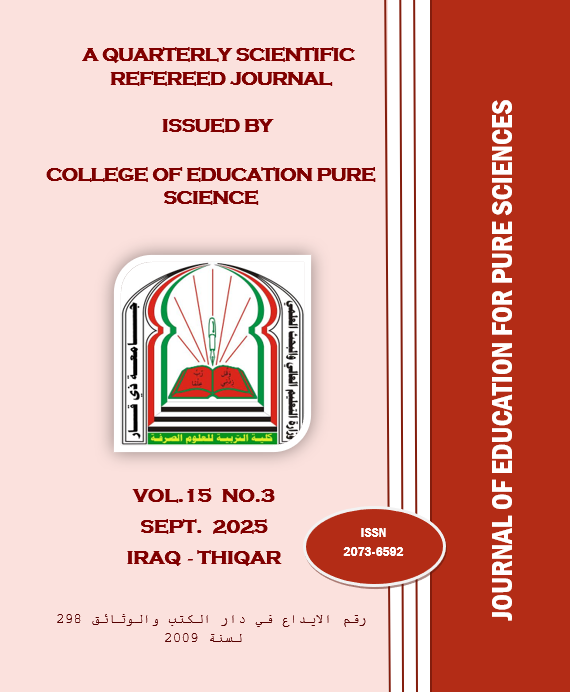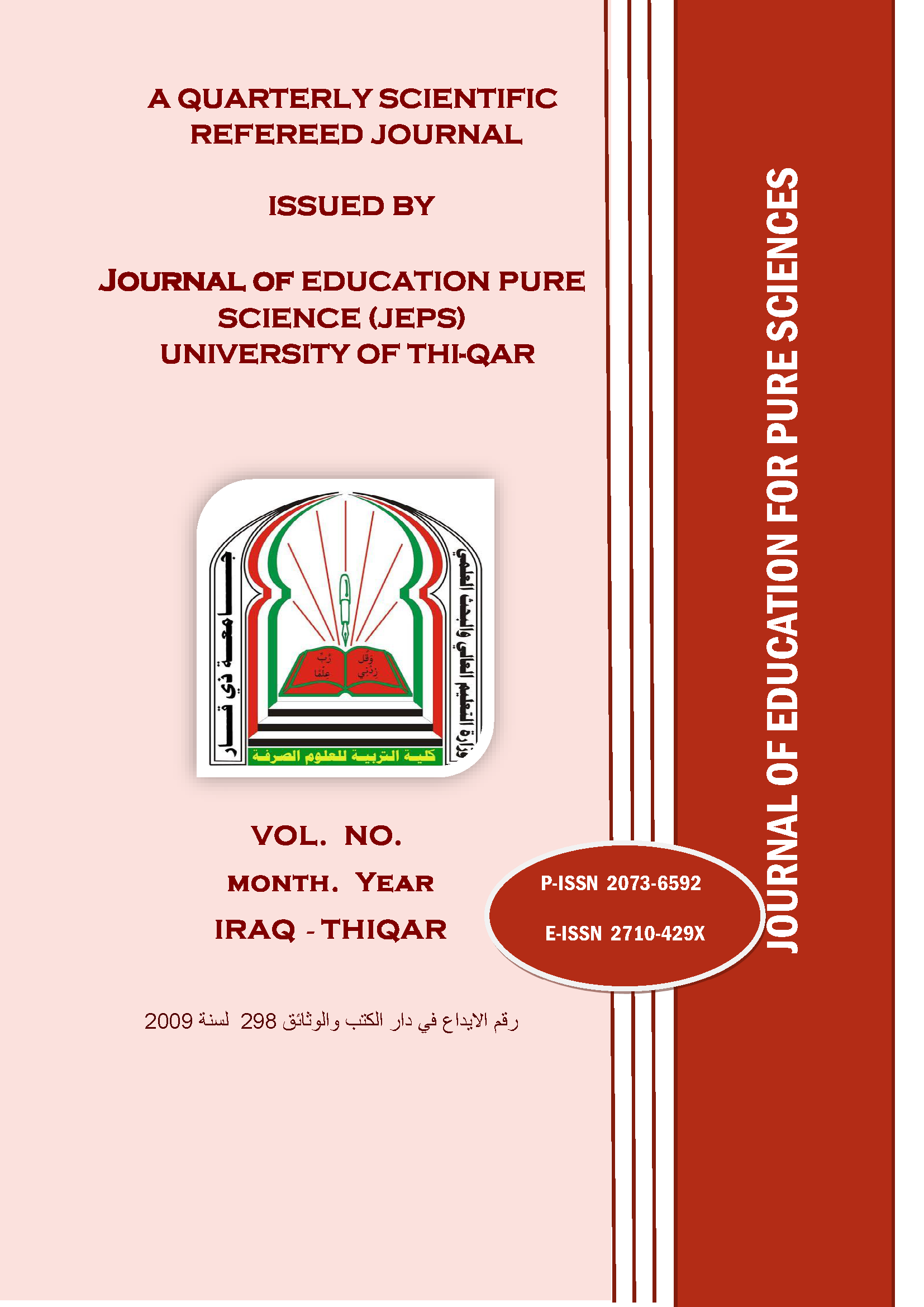The effect of polycystic ovary syndrome on the hormones of the adrenal gland
DOI:
https://doi.org/10.32792/jeps.v15i3.702الكلمات المفتاحية:
Indocrine gland، Aldosterone، Cortisol، Epinephrine، Polycystic ovary syndrome (PCOS).الملخص
متلازمة تكيس المبايض (PCOS)، التي تتميز بحدوث خلل في التوازن الهرموني والذي قد يؤدي إلى مشكلات صحية أخرى إذا لم يتم متابعتها أو علاجها بشكل مناسب، لا توجد أدلة تثبت أن لمتلازمة تكيس المبايض تأثير مباشر على الغدة الكظرية أو على الهرمونات الكظرية مثل الإبينفرين، الألدوستيرون والكورتيزول في إناث الجرذان المختبرية. وتهدف هذه الدراسة إلى التعرف على تأثير متلازمة تكيس المبايض على الغدة الكظرية من الناحية الفسيولوجية. حيث تم تقسيم 16 أنثى جرذ بالتساوي إلى مجموعتين (8 جرذان في كل مجموعة). المجموعة الأولى كانت مجموعة ضابطة (طبيعية) لم يتم إعطاؤها أي دواء، بينما تم إعطاء المجموعة الثانية فمويًا 0.2 ملغم لكل كغم من دواء الليتروزول لتحفيز متلازمة تكيس المبايض. وعند نهاية التجربة، تم استخدام عينات الدم لتقييم مستويات هرمونات الإبينفرين، الألدوستيرون، الكورتيزول، الإستروجين والتستوستيرون. وكشفت نتائج الدراسة عن زيادة معنوية في تركيز هرمونات الإبينفرين، الإستروجين والتستوستيرون، مع انخفاض معنوي في تركيز الألدوستيرون والكورتيزول. وخلصت الدراسة إلى أن الهرمونات الكظرية تتأثر بمتلازمة تكيس المبايض، مما يؤدي إلى تغيرات مرضية في الغدة الكظرية تدل على انخفاض نشاطها.
المراجع
• Azziz, R., et al. (2004). The Androgen Excess and PCOS Society criteria for the polycystic ovary syndrome: the complete task force report. Fertil Steril, 91(2), 456–488. https://www.fertstert.org/article/S0015-0282(08)01392-7/pdf
• Bornstein, S. R., Engeland, W. C., Ehrhart-Bornstein, M., & Herman, J. P. (2004). Dissociation of ACTH and glucocorticoids. Trends in Endocrinology & Metabolism, 15(5), 175–180. https://doi.org/10.1016/j.tem.2004.03.007
• Carter, J. R., Panerai, R. B., & Robinson, T. G. (2012). Sympathetic neural responses to stress in women with polycystic ovary syndrome. Clinical Autonomic Research, 22(1), 39–45. https://doi.org/10.1007/s10286-011-0133-0
• Duleba, A. J., & Dokras, A. (2012). Is PCOS an inflammatory process? Fertility and Sterility, 97(1), 7–12. https://doi.org/10.1016/j.fertnstert.2011.11.023
• Elenkov, I. J., Wilder, R. L., Chrousos, G. P., & Vizi, E. S. (2000). Stress, catecholamines, and immune response. Neuroimmunomodulation, 7(3), 161–179. https://doi.org/10.1159/000026484
• Elsenbruch, S., Hahn, S., Kowalsky, D., Henschel, F., Möhler, H., Janssen, O. E., & Mann, K. (2003). Altered responses of the hypothalamus–pituitary–adrenal axis and the sympathetic nervous system to stress in women with polycystic ovary syndrome. Journal of Clinical Endocrinology & Metabolism, 88(12), 6296–6302. https://doi.org/10.1210/jc.2003-030346
• González, F., Rote, N. S., Minium, J., & Kirwan, J. P. (2012). Inflammation in polycystic ovary syndrome: underpinning of insulin resistance and ovarian dysfunction. Steroids, 77(4), 300–305. https://doi.org/10.1016/j.steroids.2011.12.003
• Kafali, H., Iriadam, M., Ozardali, I., & Demir, N. (2004). Letrozole-induced polycystic ovaries in the rat: a new model for cystic ovarian disease. Archives of Medical Research, 35(2), 103–108. https://doi.org/10.1016/j.arcmed.2003.11.005
• Kauffman, A. S., Thackray, V. G., Ryan, G. E., Tolson, K. P., Glidewell-Kenney, C. A., Semaan, S. J., ... & Mellon, P. L. (2015). Polycystic ovary syndrome: a neuroendocrine perspective. Frontiers in Neuroendocrinology, 39, 1–15. https://doi.org/10.1016/j.yfrne.2015.08.002
• Lara, H. E., Ferruz, J. L., Luza, S., Bustamante, D. A., Borges, Y., & Ojeda, S. R. (2000). Evidence for a local effect of noradrenaline on ovarian steroidogenesis in polycystic ovary syndrome. Endocrine, 12(3), 267–274. https://doi.org/10.1385/ENDO:12:3:267
• Nieman, L. K. (2015). Cushing’s syndrome: Update on signs, symptoms and biochemical screening. European Journal of Endocrinology, 173(4), M33–M38. https://doi.org/10.1530/EJE-15-0461
• Rashid, N., Moulana, M., Abid, S., & Hussain, T. (2013). Angiotensin II type 1 receptor expression is altered in PCOS rat model. Journal of Endocrinological Investigation, 36(10), 796–802. https://doi.org/10.3275/8992
• Stener-Victorin, E., Padmanabhan, V., Walters, K. A., & Campbell, R. E. (2010). Animal models for the study of PCOS: a critical assessment. Molecular and Cellular Endocrinology, 373(1–2), 76–86. https://doi.org/10.1016/j.mce.2012.10.005
• Wang, N., Zhang, Y., Wang, Y., Ma, X., & Zhang, J. (2019). Hormonal regulation of steroidogenesis in polycystic ovary syndrome. Reproductive Biology and Endocrinology, 17(1), 1-10. https://doi.org/10.1186/s12958-019-0505-2
• Wang, Y., Ma, X., Zhou, L., Liu, Y., Ma, Z., & Wang, Y. (2016). Aromatase expression in adipose tissues and its role in hyperestrogenism in PCOS rat model. Endocrine Journal, 63(2), 123–130. https://doi.org/10.1507/endocrj.EJ15-0423
• Zhao, X., Xu, F., Qi, L., Zhang, D., & Wu, X. (2018). Endocrine and metabolic characteristics of a PCOS rat model induced by DHEA. Journal of Ovarian Research, 11(1), 45. https://doi.org/10.1186/s13048-018-0415-4
التنزيلات
منشور
إصدار
القسم
الرخصة
الحقوق الفكرية (c) 2025 Journal of Education for Pure Science

هذا العمل مرخص بموجب Creative Commons Attribution-NonCommercial-NoDerivatives 4.0 International License.
The Authors understand that, the copyright of the articles shall be assigned to Journal of education for Pure Science (JEPS), University of Thi-Qar as publisher of the journal.
Copyright encompasses exclusive rights to reproduce and deliver the article in all form and media, including reprints, photographs, microfilms and any other similar reproductions, as well as translations. The reproduction of any part of this journal, its storage in databases and its transmission by any form or media, such as electronic, electrostatic and mechanical copies, photocopies, recordings, magnetic media, etc. , will be allowed only with a written permission from Journal of education for Pure Science (JEPS), University of Thi-Qar.
Journal of education for Pure Science (JEPS), University of Thi-Qar, the Editors and the Advisory International Editorial Board make every effort to ensure that no wrong or misleading data, opinions or statements be published in the journal. In any way, the contents of the articles and advertisements published in the Journal of education for Pure Science (JEPS), University of Thi-Qar are sole and exclusive responsibility of their respective authors and advertisers.





